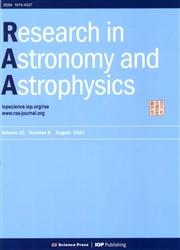HMI/SDO和SP/Hinode共时矢量磁图的比较
IF 2.8
4区 物理与天体物理
Q3 ASTRONOMY & ASTROPHYSICS
引用次数: 0
摘要
精确测量太阳磁场对了解太阳磁场的形成和演化具有重要意义。目前,有两种类型的太阳磁场测量仪器:基于滤波器的磁力仪和斯托克斯偏振仪。前者给出了高时间分辨率的磁图,后者提供了更精确的磁场测量。将滤波磁图与Stokes偏振仪的磁图进行校正是结合两种磁图优点的好方法。我们的前期研究表明,与日月号上的偏振光谱仪(SP)获得的磁图相比,怀柔太阳观测站的滤光片太阳磁场望远镜(SMFT)和SOHO上的滤光片迈克尔逊多普勒成像仪(MDI)获得的磁图低估了磁图中的磁密度和两种仪器磁图中中心到边缘的系统变化。本文以75个稳定α黑子的矢量磁图为样本,将太阳动力学观测台(SDO)上的日震磁成像仪(HMI)获得的矢量磁图与SP/Hinode获得的同时矢量磁图进行了比较。我们的分析表明,HMI/SDO磁图的纵向和横向磁密度与SP/Hinode磁图非常接近,HMI/SDO磁图的中心-边缘系统变化非常小。我们的研究表明,像HMI/SDO所做的那样,使用基于滤波器的磁像仪来构建低光谱分辨率的Stokes剖面,可以在很大程度上消除滤波器型测量的缺点,同时仍然具有高时间分辨率的优势。本文章由计算机程序翻译,如有差异,请以英文原文为准。
A comparison of co-temporal vector magnetograms obtained with HMI/SDO and SP/Hinode
Abstract Accurate measurement of magnetic fields is very important for understanding the formation and evolution of solar magnetic fields. Currently, there are two types of solar magnetic field measurement instruments: filter-based magnetographs and Stokes polarimeters. The former gives high temporal resolution magnetograms and the latter provides more accurate measurements of magnetic fields. Calibrating the magnetograms obtained by filter-based magnetographs with those obtained by Stokes polarimeters is a good way to combine the advantages of the two types. Our previous studies have shown that, compared to the magnetograms obtained by the Spectro-Polarimeter (SP) on board Hinode, those magnetograms obtained by both the filter-based Solar Magnetic Field Telescope (SMFT) of the Huairou Solar Observing Station and by the filter-based Michelson Doppler Imager (MDI) aboard SOHO have underestimated the flux densities in their magnetograms and systematic center-to-limb variations present in the magnetograms of both instruments. Here, using a sample of 75 vector magnetograms of stable alpha sunspots, we compare the vector magnetograms obtained by the Helioseismic and Magnetic Imager (HMI) aboard Solar Dynamics Observatory (SDO) with co-temporal vector magnetograms acquired by SP/Hinode. Our analysis shows that both the longitudinal and transverse flux densities in the HMI/SDO magnetograms are very close to those in the SP/Hinode magnetograms and the systematic center-to-limb variations in the HMI/SDO magnetograms are very minor. Our study suggests that using a filter-based magnetograph to construct a low spectral resolution Stokes profile, as done by HMI/SDO, can largely remove the disadvantages of the filter-type measurements and yet still possess the advantage of high temporal resolution.
求助全文
通过发布文献求助,成功后即可免费获取论文全文。
去求助
来源期刊

Research in Astronomy and Astrophysics
地学天文-天文与天体物理
CiteScore
3.20
自引率
16.70%
发文量
2599
审稿时长
6.0 months
期刊介绍:
Research in Astronomy and Astrophysics (RAA) is an international journal publishing original research papers and reviews across all branches of astronomy and astrophysics, with a particular interest in the following topics:
-large-scale structure of universe formation and evolution of galaxies-
high-energy and cataclysmic processes in astrophysics-
formation and evolution of stars-
astrogeodynamics-
solar magnetic activity and heliogeospace environments-
dynamics of celestial bodies in the solar system and artificial bodies-
space observation and exploration-
new astronomical techniques and methods
 求助内容:
求助内容: 应助结果提醒方式:
应助结果提醒方式:


